Zoe Saadia's Blog
January 8, 2016
Sold into slavery? Not the end of the world
To be a pipiltin, a noble, was good. Whether residing next to the imposing cultural center, among the magnificent temples, palaces and ceremonial enclosures with a full size ball court and a beautiful plaza, or living in the colorful neighborhoods consisted of two-storey stone houses, you would have nothing to complain about. Wealthy citizens, traders, artisans and minor nobility lived well.
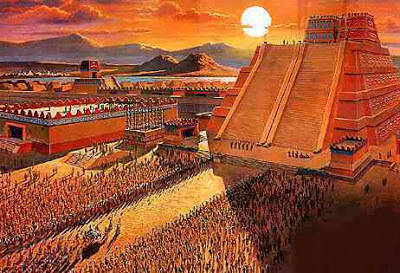
But closer to the marketplace and the harbor areas, the dwellings turned into lower, simpler looking constructions, sporting logs or cane-and-reed houses and much less wealth and color.
So if you were macehuatlin, a commoner, you would live around those areas, enjoying less luxury and more of a hard work. Each morning you would wake up with dawn, ready to go to work, whether to row out in order to farm your chinampa (floating man-made farms that covered considerable parts of the Lake Texcoco), or heading for your workshop to do various urban crafts. You would be expected to serve in the army too, but usually as a simple warrior, unless you managed to distinguish yourself and so start climbing the ranks.
If it happened, you would be better and better off, accumulating wealth and influence, eventually moving into a better neighborhood and acquiring slaves to make your life easier. You would be even allowed to wear jewelry like noble people, because the commoners were forbidden certain costly adornments and cotton clothes. They were not to drink octli in public and to be idle about their duties, expected to lead righteous, generally humble lives. Organized into calpulli, districts, they got by, working together, answerable to the elected head of their district, who was in his turn reporting to the representatives of the city administration.
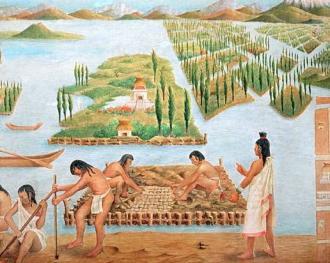
So, just in case your prospective career as a brave, fearless warrior didn’t work, you would have to accept your lot and work diligently and with no complains, because if you succumbed to crime or gambling you may end up in a worse position, selling yourself into slavery, or sentenced to it by a court.
Tlacotin, slave, was the next lower step in the Mexican Valley societies. But as opposed to some other ancient cultures, slaves composed relatively small percentage of the general population, maybe because the slavery was almost never for life.
Slaves could be either captives taken from the conquered lands (opposed to the general belief, only the captive warriors were qualified to be sacrificial victims; no commoners or women and children faced that fate), or they were commoners who sold themselves into slavery to pay debts, survive poverty or serve their time if convicted by a court.

The crimes sentenced to slavery varied from failure to pay tribute to theft, but even a murderer could end up turning into a slave. Convicted of murder person would usually be executed, but if the family of the victim wanted him to serve as their slave, the judge might be forthcoming. Also if a man murdered a slave, the owner of the destroyed property could demand this person to serve as a slave instead.
Theft and rape often resulted in slavery, as well. And so was the crime of selling free people (like selling slaves’ children, who were legally free; in this case both the seller and buyer would be enslaved). A slave who had sold himself voluntarily might have saved money and paid the same price to gain his freedom back.
So basically the slaves were not outside the law, relatively protected from mistreatment, allowed to have families, possessions and even slaves of their own, entitled to appeal to courts in the case of mistreatment. There were even some legal benefits, like an exemption from paying a tribute and serving in the army. It was not illegal for the slaves to marry a free person and there was no social stigma attached to such unions and their fruits. The children of the slaves were born free people.
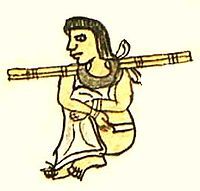
Many slaves were brought in from foreign lands, to be sold in the central markets of the large altepetls. Like with any other state activity, the government regulated this trade and it was illegal to sell an obedient slave against his or her wishes. In his turn, if the slave disobeyed his master, he was the one to be dragged into court, with the charges brought against him, backed by witnesses. A public warning would be ensued for the first time offender, but a few more of such warnings would see a slave chained with a wooden collar and sold for good. If this happened more than three time, a slave would be branded as troublesome, handed to the government for public works or sacrifice, creating the ultimate three strikes rule.
In Tenochtitlan there was another interesting law about slavery. On the way to the slave market, when the slave was about to be sold or resold, if he managed to get away and make his way to the palace without being stopped, he would be considered as free man. The only person allowed to chase that slave was the owner, or the owner’s son. No one else was to interfere, under the pain of becoming a slave himself.
An excerpt from “The Warriors' Way”, Pre-Aztec Trilogy, book #3.

As the grayish mist spread, Mino could make out the colorful wall behind their back and to their left. They seemed to be placed in the corner of the alley, between two marble columns. Ahead, there was a small pool and a few stone benches. Her eyes could make out a large tented podium, a dark threatening shape in the semidarkness.
The air was brightening rapidly. Hurriedly, she doubled her efforts to cut her ties against the crude pole.
“Would you stop doing that!” cried out someone behind her back.
She gasped, startled. Turning her head as far as she could, she met a pair of glaring eyes.
“Stop rocking this thing. It’s annoying,” said the man, now more calmly.
“I want to get out of here. Don’t you?”
“Where to, silly girl?” The man snorted and pushed the pole toward her, hitting her back.
“I don’t care. I’ll stop when my ties come off.”
A woman to her left laughed. “The ties are not your problem, girl. You have nowhere to go.”
“I can go home,” said Mino, resuming her rubbing.
“Where to?”
“The Smocking Mountain, around altepetl of Texcoco. The Highlands.”
“A long way!”
“I don’t care.”
“It’s the girl that was caught tonight, on our way here, isn’t it?” called another voice, its accent heavy. “You didn’t get very far the first time, little one, did you?”
Mino ignored them, working on.
“She can do that sanctuary thing,” said the woman to her left.
“What sanctuary thing?” The man with the accent snorted.
“They say if a slave manages to break free and run all the way to the Palace, he is a free man.” The woman paused, trying to turn her head and observe her audience – an impossible feat when one is tied to the pole and can only turn one’s neck.
“None of us would make it,” said another woman. “The whole market would be after such a slave.”
“But there is another rule,” said the first woman. She paused again, savoring the moment. “Only the owner of that slave or his sons is allowed to participate in the chase. None of the others. Not even the warriors.”
“Are you sure about this custom?” asked the man with the accent. “How do you know about it?”
“I know. Trust me to know,” said the woman importantly.
Mino felt the string loosening. “We don’t know the way to the Palace,” she said, her eyes on two men appearing from around the podium. She stopped moving and clasped her sweaty palms behind her back.
The other slaves fell silent as the two men approached, eyeing the tied people. One leaned forward, studying every face, one by one, carefully and thoughtfully.
If you enjoyed this post, more gossipy bits on pre-contact Mesoamerica can be found on www.precolumbianhistory.com/
At Road's End
The Young Jaguar
The Jaguar Warrior
The Warrior's Way
February 25, 2015
Atenaha, the Seed Game that even the deities played
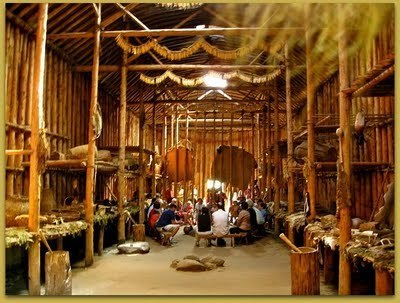
As the Father Sun would be rolling down, progressing toward his resting place, you might get start enjoying this well deserved rest, engaging in throwing games with your equally tired but restless peers. After all, you all have already completed your chores, washed in the nearby stream and ate the warmed meal prepared by the women of your family in the morning. So it might be the time to have some idle fun.
Atenaha – a seed game – required little accessories and not much preparation or skill. Like dice it was a game of luck, mainly, to pass an idle afternoon. With blanket, folded and thoroughly smoothed, acting like a game-board, eight small wooden, or carved out of elk horn, disks, burned or blackened on one side each, and a pile of seeds or beans, forty in amount, you and your friends were set to go.
The first player would grab the stones, shake them thoroughly, then throw, making sure none slipped between his palms while mixing them vigorously (such misfortune could see the player losing his round no matter what his throw brought).
The array of the dice upon the blanket would determine the players’ achievement per round. If the stones spread out displaying their blackened sides, all eight of them, you would whoop with joy and earn twenty points, sweeping twenty seeds/beans out of the central pot and into your private stockpiles. This was the luckiest throw.
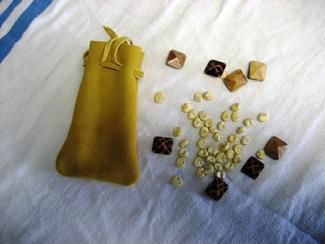
Still, if your discs would spread on the blanket all displaying their unpainted sides, you would probably not be heard complaining. Ten points such throw would earn you is not likely to see you desperate.
Seven painted/unpainted sides would give you four points, and six would still see you collecting two seeds out of the pot. Nothing to boast about, but not the total failure, either. Any less than that – five painted as opposed to three unpainted, or the other way around, and so on – would earn you nothing, but the loss of your round. Not the end of the world, but you might still get thoroughly angered.
So at this stage the players would be fully engaged, enjoying themselves, most probably ignoring the ominous glances of the passing-by ever-busy Clans Mothers – the elderly women who ran the council of each longhouse and who were bound to frown on such idle pastime. Yet, the players would be too busy for that now, using one hand to throw, and the other to hide their winnings. In many versions of the game a lucky throw would earn the participants another round ahead of his peers.
And so the game would continue until the pot with the seeds empties. By this point some would have hoarded high piles of beans, while the others would sport smaller heaps, or nothing at all. A player without earnings could continue but usually not for long.
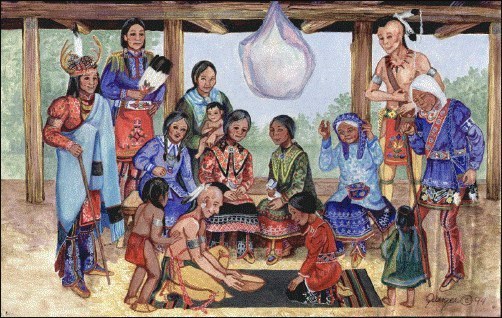
Because at this point the game changes.
If before each earned point was compensated out of the central pot of seeds, now it would have to come out of the piles owed by the fellow players. So if you had nothing left but it was your turn to throw and you were lucky enough to earn a point or two, you would be off for a passable re-start.
But if it was someone else’s turn, you would be very likely kicked out of the game the moment your companion earned even the minimal amount of points, because everyone was required to cache in. For example, a throw of all-whites – worthy of ten points as you remember – would require the remaining players, say three of them, to give the lucky winner each three or four seeds. If you have nothing to give, you were out. But the game would go on. Also if you had two seeds instead of the required three, out you would go as well, bankrupted, with what you had left behind divided between the rest of the players.
This is the point when the game turns into a race against one another, with the ultimate victor being the person who remained in possession of all seeds.
The end of the game.
Time to collect the bets, if anything was wagered against the victory, to go home and store your newly acquired goods. Or to engage in a new round of game. Like anywhere else around the globe, the People of the Longhouse (the Iroquois) were fond of gambling.
An excerpt from “The Peacekeeper”, The Peacemaker Series, book #4.
...
"Are you going to fall asleep on us, you vigorous player?”
His companions’ laughter made Hainteroh concentrate.
“Didn’t notice it was my turn.”
Collecting the marked stones, he smoothed the surface of the folded blanket, making sure it was ready for his throw.
“Of course you didn’t notice. When one is staring into thin air the way you were, one is prone to missing the goings-on. What were you dreaming about?”
“Nothing. Nothing out of the ordinary.”
Their renewed laughter did not make him angry, not like it would have only a few seasons earlier, in his previous life, when unimportant things had mattered. Back then he would have challenged anyone who dared to laugh or tease him, especially in front of his peers. Today he just shrugged, shaking the stones briefly, throwing them over the smooth surface, watching the marks, his heartbeat not quickening. The outcome of the game did not matter either, any more than their amusement with his wandering attention did.
“Your throw.” Indifferently, he pushed the stones toward the man to his left, collecting the dry seeds out of a large bowl, the four seeds that his throw had earned him.
“Don’t you care if you win or lose?” asked one of the others, a tall man with a spectacular scar running down his left cheek. “You will fall asleep on us for real in the end.”
Hainteroh shrugged. “No, I don’t.”
“What do you care about?”
“Other things.”
“Like what?”
He stifled a yawn. “Important things.”
The stones landed upon the folded blanket again, some rolling outside it, some slowing among the wrinkles. Two painted, six unpainted. The man beside him cursed. His stack of seeds was meager, and the addition of only two more did nothing to encourage his spirit.
“So what are the important things you do care about?” insisted the man with the scar.
Hainteroh fixed his gaze on the rolling pebbles, the throw of a youth to his left forceful, making the stones scatter outside the blanket.
“Same as yours.”
“How do you know what I deem important?”
The man was watching him, challenging, not about to give up.
“I don’t.” He shrugged again, not feeling threatened. “For myself, I want to kill as many of the filthy lowlifes from across the Great Sparkling Water as I can.” He met his interrogator’s gaze. “I want to burn down their towns and villages and make them suffer for real.” Shrugging again, he narrowed his eyes. “Don’t you want that, too?”
The youth’s curse distracted them as the stones came to a halt, displaying five painted against three unpainted sides. No seeds were to be collected for such a throw.
“Bad turn.” The fourth player grabbed the throwing stones. “But it’s your fault. You don’t toss the poor stones with such violence. One needs to give them proper time to mix between your palms, to feel your warmth. That will reassure them, make them feel calm and unthreatened. Then they will roll and try to do their best for you.” As they listened to the pleasantly monotonous rustling, the man grinned in a slightly condescending manner. “As for the enemy from across our Sparkling Water, you all may need to gather your patience and hold onto your temper as best you can.” A glance shot at Hainteroh was openly amused. “Which won’t be easy for some of you, young hotheads that you are.”
“What do you mean?” He didn’t watch the pebbles as they spread upon the blanket, in a neat pattern, as though prearranged, but the gasps of the others told him the throw was good, maybe too good.
..."
If you enjoyed this post, more gossipy bits on pre-Columbian Americas can be read www.precolumbianhistory.com/atenaha-t...
Two Rivers
Across the Great Sparkling Water
The Great Law of Peace
The Peacekeeper
September 10, 2012
The Golden Hammer & Anvil Shield
 Stuart MacAllister, HNS reviewer, author and U.K. book blogger Sir Read-A-Lot, announced a new award, the Golden Hammer & Anvil Shield, for books that are “...impeccably crafted, where authors have taken care to ensure their manuscript is properly edited and prepared to a professional standard and where the story evokes thought and emotion long after the final sentence has been read...”
Stuart MacAllister, HNS reviewer, author and U.K. book blogger Sir Read-A-Lot, announced a new award, the Golden Hammer & Anvil Shield, for books that are “...impeccably crafted, where authors have taken care to ensure their manuscript is properly edited and prepared to a professional standard and where the story evokes thought and emotion long after the final sentence has been read...” My historical novel “At Road's End”, the first book in the Pre-Aztec Series, was honored to be one of the four chosen novels.
My historical novel “At Road's End”, the first book in the Pre-Aztec Series, was honored to be one of the four chosen novels.
The announcment can be seen here: http://sir-readalot.blogspot.co.uk/20...
May 20, 2012
The Rise of the Aztecs (part III, Tenochtitlan)
“… When we saw so many cities and villages built in the water and other great towns on dry land we were amazed and said that it was like the enchantments… great towers and cues and buildings rising from the water, and all built of masonry. And some of our soldiers even asked whether the things that we saw were not a dream…”
”
Bernal Diaz del Castillo, The Conquest of New Spain
Yet only a century earlier Tenochtitlan was nothing but a swampy unimportant island-city, looked down upon by its haughty, powerful neighbors.
In the Angry Aztecs Part I we dealt with the incident of the flayed princess and the first time the Aztecs had made their powerful neighbors angry.
And then, in the Angry Aztecs Part II, they had made it to their swampy little island, relatively safe under the stern gaze of the Masters of the Valley, the Tepanecs.
So now we arrive to the end of the 14th century, when the Aztecs were somewhat better off.
Not allowed to campaign on their own, they still thrived, fighting under the Tepanec leadership, relatively safe upon the swampy little island of theirs.
Required to pay tribute every full moon, they contributed to the riches of the powerful Azcapotzalco, the Tepanec Capital. The tribute was reported to be ‘oppressive and capricious’.
Their island location has its benefits. Separated from the mainland by a certain amount of water and, thus, safe from any military surprises, the young Aztec nation was relatively safe.
Yet, this location has its disadvantages as well. Bringing materials to the rapidly growing city was difficult, so most of the houses were still reed-and-cane built. The markets were poor and the city could not even dream of building a worthwhile temple or, gods forbid, a pyramid. Large slabs of stone and marble were impossible to bring by canoes.
But the Aztecs were not only a warlike nation.
They turned out to be ambitious engineers as well.
So, when Acamapichtli, a young and very vigorous ruler, was brought to lead the city, the Mexica energetic people launched into several breathtaking projects at once.
First of all, the island was enlarged artificially, with much dirt and rock. Then a causeway was built to connect it with the mainland, making it possible for the large chunks of materials to be brought into Tenochtitlan, allowing the construction of the Great Pyramid’s second stage.
Houses of cane and reed were replaced by the stone ones, temples constructed, laws made.
The agriculture was a problem. The island was too small to cultivate enough crops to support the rapidly growing population. Cultivating of many chinampas, the ‘floating gardens’, had helped. Yet the Aztecs needed more land. So far they were masters of their island only. They needed a permission to campaign on their own.
Well, Acamapichtli was a great diplomat. Careful not to provoke the Tepanec overlords, Tenochtitlan paid its taxes in time and when Azcapotzalco wanted a present in a form of a floating garden of beautiful flowers, a special chinampa was made in a hurry and floated over the lake straight to the shores of the Tepanec’s Capital.
Finally, after many such gestures and negotiations, the Aztecs were allowed to campaign on their own, provided their warriors kept reinforcing the Tepanec forces with the same vigor as before. The northern settlements of the lake, such as Xochimilco were attacked immediately and their lake-shores chinampas captures and put to a great use.
Tenochtitlan was growing rapidly.
An excerpt from 'The Jaguar Warrior', the third book in Pre-Aztec series:

"...
Her eyes flashed.
“I was glad, very glad! My husband is a great ruler and he is just beginning his journey. Tenochtitlan will be the greatest altepetl in the whole Valley one day. It will make Azcapotzalco look small. But by then Azcapotzalco may be just a cluster of ruins.”
He stared into her eyes, mesmerized. What she said was completely ridiculous, yet for a moment he believed her. Her eyes shone with such an intense power, radiating her hatred and more. Was she having a premonition?
He shuddered. “What you say does not make sense. Acamapichtli is an impressive man, I admit that. But he is leading a small nation that is stuck on a muddy island. His city has nowhere to grow. This altepetl cannot evolve beyond a mediocre status. You have nowhere to expand.”
“Oh, but you know so little. And you were never bright anyway. But Acamapichtli is. He is so very wise, wiser than my father even. And he is patient. He plans for twenty, two-times, three-times twenty summers from now and he works to that end. He has grand visions and he has the ability to apply his ideas patiently and carefully. He invests all his energy in his plans, but he does so smartly and patiently. You just wait and see.”
He watched her animated face. Two red spots colored the high cheekbones now and the large eyes shone brightly, almost excitedly. He had never seen her like that. Yet, what she said made his skin crawl.
“It feels too familiar,” he said tiredly. “But you should know better than to use me again. I cannot be trusted. In the end I will not betray my people. You should know it better than anyone.”
...
A sample chapter can be read on http://www.amazon.com/Jaguar-Warrior-...
April 22, 2012
The Rise of the Aztecs (part II)
What should the Tepanecs do with their new neighbors known as Mexica-people-from-Aztlan or the Aztecs?
The despised would-be-aristocrats got themselves into a trouble all right, enraging their previous patrons of Culhuacan. To flay a princess, of all things! Azcapotzalco’s Tepanecs shook their heads. Clearly the troublesome newcomers had no finesse. No finesse at all.
But those Aztecs had one advantage - they made great warriors. So the Tepanec rulers saw their chance. First they had launched series of raids against their neighbors in trouble, to make those understand which nation around Texcoco Lake was the most powerful to be reckoned with. Just in case it wasn’t yet clear.
Then, after thoroughly humbling the most warlike of their neighbors, they'd promptly took them under Azcapotzalco’s protection, against the wrath of Culhuacan.
The small Aztec nation was safe for now, but there was a price to pay. The Aztecs were to supply their new patrons with an unlimited amount of warriors whenever demanded.
And the Tepanecs didn’t make them wait. While the Aztecs were busy developing their new capital upon the muddy island of the great Lake, the demands began trickling in. The Azcapotzalco’s ruler had decided to turn on their historical rival – Culhuacan.
Reinforced by a horde of the warlike new allies, Azcapotzalco’s warriors had pounced on its sister-city, in less than ten summers succeeding in taking over all of their trading routes and dependable towns and villages. The surrounding districts and settlements, which had paid a tribute to Culhuacan up to these days, began sending their yearly payments to Azcapotzalco instead.
The Tepanec Empire was expanding.
An excerpt from 'The Young Jaguar', the second book in Pre-Aztec series:

Tecpatl nodded, glancing toward the wide opening in the wall, catching a glimpse of the beautiful garden outside. He could hear the water trickling in the ponds.
The eyes boring into him went flat. “Do you think Tezozomoc would make a good ruler? Would he be the right choice?”
Tecpatl returned the gaze. “It is not my place to judge on such matters.”
The heavyset man nodded and almost visibly relaxed. He was getting old, thought Tecpatl. Once upon a time this formidable man would not be readable under any circumstances.
The urge to escape the Palace welled. He thought of the spaciousness of his own gardens, of the feast that was sure to contain every delicious snack he had ever indicated as his favorite, of the ardent, exuberant welcome home which was sure to await him. He could see her, dressed in the best of her clothes, bathed and groomed, waiting for him, exalted and impatient; still beautiful, still desirable, still in love with him, still unruly and not fitting, just like fifteen summers ago when he had met her for the first time.
“You are sure Tezozomoc will give you all the commands you might desire.” The older man made it a statement.
Tecpatl forced his mind to concentrate.
“I hope he will trust me as has his father before him.”
“How long will it take to make Culhuacan crumble?”
“Not very long. Their warriors have grown soft. They are not a worthy enemy anymore.” Relieved to steer from the dangerous ground of politics, he added:
“I’ll be happy to finish them off and re-open the war against the Mayans.”
“Not the Aztecs?”
“Oh, the Aztecs make good warriors. But they are barbarians. They are few and unimportant. Culhuacan is the worthy enemy. They are our equals, our peers.”
The face of the elder man remained still, but something in the depths of the narrow eyes changed. “You do wise staying away from the Palace’s affairs. You are a warrior and you would better keep it that way.”
...
read a sample on https://www.smashwords.com/books/view...
or http://www.amazon.com/Young-Jaguar-Pr...
February 15, 2012
The Rise of the Aztecs (part I)
The lands of the Mexican Valley were amazingly rich, dotted by large city-states, with Azcapotzalco, the most powerful of them all. Of course, there was Culhuacan, boasting its Toltec origins, sprawling upon the southern side of the lake, as influential and as strong, even if Azcapotzalco’s Tepanecs refused to admit it.
The densely populated region was well under control. Still, the unabashed newcomers streamed in and managed to find themselves a very favorable piece of land on the western shore of the lake, fertile and abounded with streams. There they began to flourish, while the suspicious mood of their powerful neighbors grew proportionally. Those Aztecs would not be contented with a small role of another city state, could see the elders of Azcapotzalco. And nothing more would be tolerated.
The tension grew and, toward the end of the 13th century, Azcapotzalco rulers had expelled their troublesome new neighbors. But for the rulers of Culhuacan, it could have been the end of it. For reasons unknown, Culhuacan had decided to allocate the expelled Aztecs a little land at the empty barrens of Tizaapan. Maybe they wanted to keep an eye on those fierce groups of foreigners, to make sure they would not grow too strong. Azcapotzalco’s people were doubtful, united in their suspicions. The further those troublesome newcomers would be drove off, the better. Yet they did nothing, as the rivalry between the two powerful cities went back generations. If one decided to expel a nation, the other would support it, even if halfheartedly. So they watched carefully as the Aztecs seemed to be assimilating into the Culhuacan’s way of life.
Then the unspeakable happened! A few decades later a scandal washed the Texcoco Lake’s shores. The new ruler of Culhuacan had given his daughter to the Aztec’s ruler to marry. Or so he thought. The Aztecs promised to make her a goddess – a fate great enough even for the haughty Culhuacan princess. Well, the cultural differences showed when the princess was sacrificed in order to assist her reaching the promised status by joining the other deities. It said that the priest, wearing her flayed skin as a part of the ritual, appeared at the very festival dinner her father had honored by his presence. The Culhuacan ruler and his nobles were not amused. The roaring declaration of war could be heard in the distant southwestern realm of dwindling Anasazi, it was said.
Azcapotzalco’s Tepanecs shook their heads. Had the Culhuacan Toltecs really thought they could tame the wild beast? But now they had their own dilemmas. Should they side with Culhuacan, or would they better stay neutral? Or maybe, just to spite their old rivals, they should actually assist the despised troublemakers, as those faced a certain defeat and banishment? The warriors argued in favor of destroying the Aztecs once and for all, even if it would result in helping Culhuacan. The rulers, on the other hand, found it difficult to miss the opportunity to sneer at the old insult, when just a few decades ago, Culhuacan had sided with Aztecs against Azcapotzalco’s better judgment. Why not let them eat the meal they’ve been serving their old neighbors?
An excerpt from ‘At Road’s End’

She laughed. “Would I fit among the haughty warriors’ women?”
“I don’t know,” he said. “I don’t think our women are haughty. Not all of them, anyway. They come from many different places, brought to Azcapotzalco from practically everywhere. I’m sure you would eventually encounter even a woman from here. Culhuacan folk are the arrogant lot, impeccable Toltec as they are. Their women would be sure to look down on you through their narrow Toltec eyes. But the rest are all right, I guess.” He pondered for a while, remembering the annoying Culhuacan and the even-more-annoying Mexica newcomers who caused nothing but trouble. “Azcapotzalco is beautiful,” he added. “You would love that city.”
“Is it larger than Great Houses?”
He burst out laughing. “It’s like comparing a hill with a mountain.”
“I don’t believe you!”
“Then come and see for yourself.”
She shook her head with amusement. “Why those Cul-hu-a-can people are so arrogant, if they are living in your city? Are they warriors also?”
“Like us, some of them are warriors. The rest do the trade or work the land, do crafts or worship the gods. They have their own city. Culhuacan is situated on the southern side of our lake. They are arrogant bastards with no common sense. They always have to make all the mistakes. There were those pushy newcomers, from your regions by the way, but definitely not your people. Very fierce warriors. Azcapotzalco expelled them in the summer I was born. But Culhuacan? Oh no, they had to find them a piece of land, to spite us of course. And now, twenty summers later, those newcomers Mexica-Aztecs with no finesse, sacrificed a Culhuacan princess. So it means war and it only took them twenty summers to understand what we saw in the very beginning. Stupid, isn’t it?”
“They had sacrificed a princess? You mean they killed her?”
“Oh yes. The priest showed up wearing her flayed skin in the middle of the celebrative feast. The Culhuacan ruler, her father, and the rest of their nobility did not take it well.”
Sakuna gasped. “Wearing what?”
He turned to watch her, amused. “Insane, isn’t it? They promised to make her a goddess, but Culhuacan nobles didn’t think they meant literally to introduce her to the realm of the gods.”
“And to such a place you were offering to take me?”
“No, of course not. Those were the wild Aztec barbarians. Azcapotzalco priests are not flaying the sacrificial offerings and they would never touch a princess or any irrelevant person. Our gods receive nothing but the captured enemy warriors who answers all the criteria. We are completely civilized.”
She seemed as if shrinking as he talked. “You kill captured warriors? Why? And what if you get captured?”...
Read a sample at: http://www.smashwords.com/books/view/...
or http://www.amazon.com/gp/product/B006...
October 29, 2011
North America before the in/famous discovery – the terra incognita of historical fiction
Was anything happening on those vast, diverse lands before the 15th century?
The logic says – yeah, probably, something has to be going on over there. They say the Bering Straits were bridged several times by the most recent Ice Age, allowing some people to sneak in and spread far and wide.
Well, ok, there were people, but if you attempt to mirror history through fiction, those people did absolutely nothing for he millennias to come, patiently waiting to be discovered.
And it took time! Those who took upon themselves to write and interpret history, had really made them wait before offering them their allocated part of either a noble or a cruel savage.
Well, at least it was a nice part. So appealing, the kids all over the world love sticking feathers into their hair, playing 'in Indians' all day long. Even the adult costume parties are full of such 'Indians'.
All over the world people seems to know everything that there is to know about thousands of different cultures and nations that populated (and still are) the third largest continent, manly by sticking feathers into their heads and making loud, strange-sounding sounds (and I know what I’m talking about; I lived on three different continents for years).
Through the recent decades, pre-Columbian history seems to gain some serious attention in the textbooks (not around the world, gods forbid, but at least in North America itself). Those books are few and far between, but they are there and it’s a beginning.
Yet, in the realm of the fiction, this niche seems still vacant. There are many great novels on post-Columbian times, but none seems to look further than the end of the 15th century. Why?
Because nobody cares, I was told.
Well, it’s a tricky matter. Nobody knows, so nobody cares. Inform them, nicely enough - but that’s what historical fiction exists for - and their interest may arise.
So my novels are going to do just that :)
The Cahokian
http://www.amazon.com/The-Cahokian-eb...
October 3, 2011
If you can trace your ancestry to the Sun God himself, you would better choose your mate carefully
And it was not an easy task. Who could prove beyond any doubt that the son of the mighty Ruler was, indeed, the progeny of his divine father? After all, no DNA tests were invented just yet.
Well, those Cahokians did not go quite as far as the Ptolemies of Egypt by marrying the royal heirs to their full-blooded or half-blooded sisters. Nevertheless, they’d found a way to ensure the required purity. The full-blooded princesses were useful in more than a one way, as it turned out.
The precious blood could be diluted, but to a certain extent. So the royal heir would be married off to whichever mortal noblewoman took his fancy, permitted to make children and live happily forever after. But his children would not ascend the throne, however frustrated they may have been feeling about it. No mortal woman, as chaste as she might appear, could be trusted with delivering a pure-blooded next ruler. Women were too difficult to guard throughout their fertile years. There was no way to ensure the paternity of her child.
So was the Cahokian ruling class frustrated? Not at all! The solution was simple, as long as the royal family did not run out of princesses. Only a son the full-blooded Cahokian princess would be allowed to ascend the throne.
And so the ruler would rule contentedly, while his sons knew that no amount of intrigue would place them upon the throne atop the glorious, ten-storey-tall Cahokian Mound. And all this time the lucky son of the Ruler’s Sister would rub his hands, getting ready to take the burden of governing upon his dear Uncle’s, sometimes hastened, death.
Excerpt from “The Cahokian“:
The Cahokian leader squatted comfortably upon his mat, unimpressed by the food, but sipping from the exquisite pottery goblet with enjoyment; the locally made nectar of the gods was of an excellent quality. Absently he watched the city, stretching beneath the low mound.
“The nephew of the Great Son of The Gods does not rule Cahokia anymore. He has joined his godly ancestors before the end of the last moon.”
The local ruler spread his palms, startled. “May his time among the gods last for many lifetimes!” He shifted uncomfortably. “Who is ruling Cahokia now?”
“As our ancient tradition determines, the nephew of the previous ruler has become our current Son of The Gods.” The visitor’s fingers tightened around an exquisite pottery cup and it seemed that the fragile item would crack and break into thousands of little pieces.
“But isn’t he just a young boy?”
“He has good advisers.” The warlord’s face was no more than a stone mask, but again something shadowy lurked in the depths of the dark eyes. “Of course, his mother, the sister of the previous Son of The Gods, is an exceptionally wise woman. Her guidance will prove priceless, for the empire and its new ruler alike.” His hollow gaze strayed back toward the buzzing plaza, while the disturbing silence prevailed.
The ruler studied his haughty guest thoughtfully. “What is the purpose of your delegation?” he inquired after a while, deciding it was time to bring this Cahokian back from his dark daydreams.
The Cahokian



